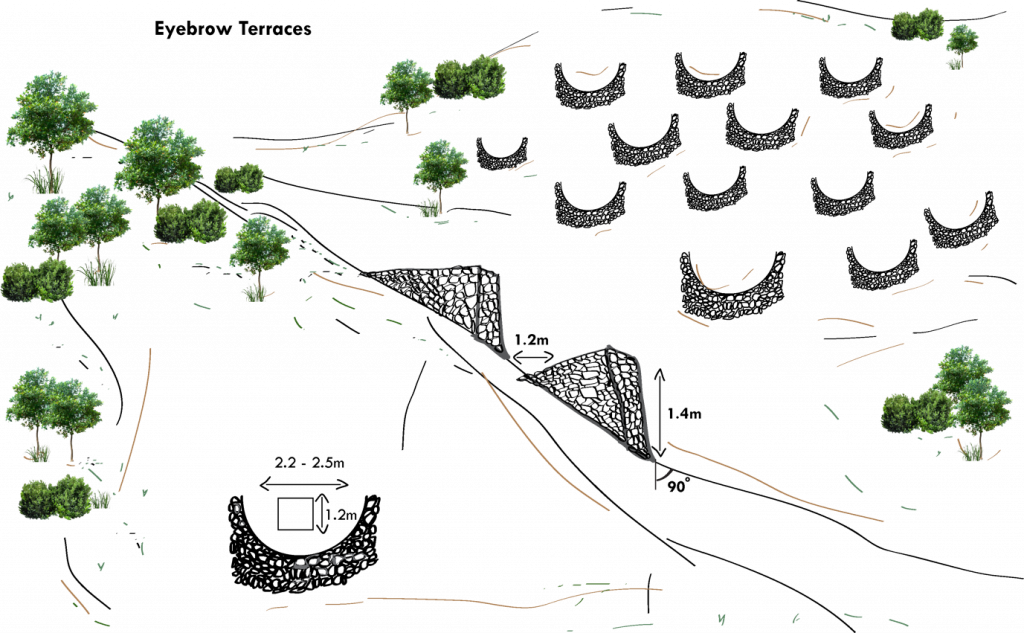Eyebrows/half moons are small, semi-circular and stone-faced structures that open in the direction of the run-off (figure 5.6). They can be built on steep slopes, usually with a maximum preferred slope of 50 percent, yet steeper gradients are possible, especially when rainfall is not torrential.
The steeper the gradient, the more the bunds have to be reinforced (by stone) in the downward toe and the higher the downward toe section becomes. The typical diameter of the eyebrow should be between 1.4-2.5 m with an infiltration or planting pit of size 40 cm wide by 50 cm deep. The suggested size of eyebrows with different gradients are given in Annex 7.

| Gradient | Stone ring diameter | Inner cross width | Backwall height | Reinforced backwall |
| 30 | 30 cm | 220 cm | 70 | – |
| 45 | 30 cm | 180 cm | 120 | 10 cm |
| 60 | 30 cm | 140 cm | 180 | 20 cm |
Abundant spoil material can be used to build up the semi-circular eyebrows. The topsoil that was removed whilst making the road can be used to fill the inner side of the semi-circular stone structure. This can be used for tree planting and can contribute to the regreening of the area. Around eyebrows/half moon, controlled grazing is essential if the area is regreened. In the forest areas, it is good to have a high density of eyebrows (see Figure 10). The preferred distance between lines of eyebrow terraces is given in the table below.
Preferred distance between lines of eyebrows terraces
| Gradient | Distance between lines of eyebrow terraces (meter) |
| 30 | 15-20 |
| 45 | 10-15 |
| 60 | 8-10 |
Stone strips
The eyebrow can be complemented by stone strips or rock bunds, in particular on slopes that are relatively even and not too steep (<50 degrees). They are built from coarse stones and boulders (see Annex 1). These stone strips will slow down run-off, intercept sediment and built-up soil layers. They will stretch over the width of the slopes, allowing water to filter through, as they are permeable. See Figure 11 and Table 4.4 for layout and design of stone stripes for different gradients. In the atmospheric conditions of Karnali the stone bunds and the eyebrows will also act as dew traps in part of the year, including the important post-monsoon period when moisture availability is at a premium. This is particularly true for spoil that contains mica and that has high thermal conductivity and will cause the stones to cool off significantly at night, triggering the formation of dew.
The minimum criteria of the stone strips are:
Basic parameters for stone strips at different gradients
| Gradient | Heigth (m) | Vertical Interval (m) | Distance between stone strips (m) |
| 30 | 1 | 2.8 | 6 |
| 40 | 1 | 2.8 | 5 |
| 50 | 1 | 2.8 | 4 |
Note: though the table shows the possibility to build stone stripes even on a 50 percent slope, the field situation needs to be observed carefully when the slope increases.

